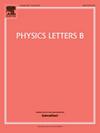Primordial gravitational waves from spontaneous Lorentz symmetry breaking
IF 4.3
2区 物理与天体物理
Q1 ASTRONOMY & ASTROPHYSICS
引用次数: 0
Abstract
We study the effect of Spontaneous Lorentz Symmetry Breaking (SLSB) on Primordial Gravitational Waves (PGWs) generated during inflation. The SLSB is induced by a time-like Bumblebee vector field which is non-minimally coupled to the Ricci tensor in the Friedmann-Lemaître-Robertson-Walker background. The power spectrum and GW amplitude are computed to investigate how Lorentz violation leaves observable imprints. We calculate the GW strain amplitude over frequencies , for a range of the dimensionless Lorentz-violating parameter, , which essentially comes from a slight sensitivity to the equation of state for dark energy. For positive l values, the amplitude of GW shows a mild suppression compared to the standard cosmological scenario (). This effect could be observable with detectors like SKA, μ-Ares, and BBO. Conversely, negative l values amplify the GW amplitude, enhancing detectability by both SKA, μ-Ares, and BBO, as well as by THEIA and DECIGO. Notably, the GW strain amplitude increases by an order of magnitude as l moves from 0 to , improving prospects for detection in high-sensitivity detectors like THEIA and DECIGO.
自发洛伦兹对称破缺的原始引力波
研究了自发洛伦兹对称破缺(SLSB)对宇宙膨胀过程中产生的原始引力波(PGWs)的影响。SLSB是由一个与friedman - lema - robertson - walker背景下的Ricci张量非最小耦合的类时大黄蜂矢量场诱导的。计算了功率谱和GW振幅,研究了洛伦兹破坏如何留下可观测的印记。在无量纲洛伦兹违反参数- 10 - 3≤l≤10 - 4的范围内,我们计算了频率上(10−10Hz,104Hz)的GW应变幅值,这基本上是由于对暗能量状态方程的轻微敏感性。对于正l值,与标准宇宙学情景(l=0)相比,GW的振幅显示出轻微的抑制。这种效应可以用SKA、μ-Ares和BBO等探测器观测到。相反,负l值放大了GW振幅,增强了SKA、μ-Ares和BBO以及THEIA和DECIGO的可探测性。值得注意的是,当l从0移动到−10−3时,GW应变幅度增加了一个数量级,这改善了在高灵敏度探测器(如THEIA和DECIGO)中的检测前景。
本文章由计算机程序翻译,如有差异,请以英文原文为准。
求助全文
约1分钟内获得全文
求助全文
来源期刊

Physics Letters B
物理-物理:综合
CiteScore
9.10
自引率
6.80%
发文量
647
审稿时长
3 months
期刊介绍:
Physics Letters B ensures the rapid publication of important new results in particle physics, nuclear physics and cosmology. Specialized editors are responsible for contributions in experimental nuclear physics, theoretical nuclear physics, experimental high-energy physics, theoretical high-energy physics, and astrophysics.
 求助内容:
求助内容: 应助结果提醒方式:
应助结果提醒方式:


